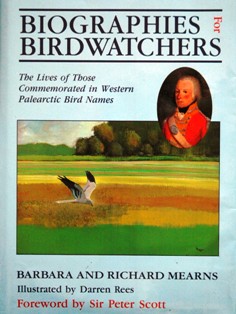Other books by Mearns & Mearns
Peatland Poems • The Bird Collectors • Audubon to Xántus • Biographies for Birdwatchers
Published April 2022:

Peatland Poems from the Scottish Solway
Barbara Mearns, Mearnsbooks, 2018, 63 pages, numerous colour photos. (No ISBN)
Only available from the author at £6.50 plus P&P (sterling cheques only). To order, send an email mentioning ‘Peatland poems’ and number wanted at Contact us.

The Lochar Moss, in SW Scotland, is one of the largest raised bogs in Europe. In the past it was an impassable quagmire, but since the 1750s it has been ruthlessly ploughed and drained for agriculture and forestry.
These 45 poems give glimpses into the former glory of the Lochar Moss and nearby peatlands. They explore the modern naturalist’s conflicting emotions of delight and grief, battling to enjoy wildlife in the face of past and current onslaughts.
Part 1 celebrates the butterflies, birds, dragonflies and other animals and plants typical of raised bogs and boggy woods. Part 2 blends humour with lament to focus on the current state of ‘Razed bogs’. Part 3 follows the Lochar Water from its first hilltop trickle through freezing fog, winter floods and spring sunshine to its final meanders through the clover meadows of the Wildfowl and Wetland Trust Reserve on the Solway coast. The final section looks back over 6,000 years of human interactions with peatlands, including a Bronze Age dug-out canoe and Iron Age torc discovered on the Lochar Moss and the siege of Caerlaverock Castle in 1300.
‘Bogs beckon on reading these wonderfully evocative poems.’
Chris Rollie, RSPB Area Manager, Dumfries & Galloway.
The Bird Collectors
 Academic
Press, London & San Diego. 1998. Pp. xvi, 472, numerous
black-and-white photographs, 4 maps, 3 tables, 1 appendix. ISBN
0-12-487440-1.
Academic
Press, London & San Diego. 1998. Pp. xvi, 472, numerous
black-and-white photographs, 4 maps, 3 tables, 1 appendix. ISBN
0-12-487440-1.
Signed copies available from B & R Mearns to UK addresses only,
£60 (includes postage and packing)
Every birdwatcher and ornithologist owes a debt to the bird collectors. Their skin collections and associated data have provided essential material for basic ornithological studies on classification, evolution, conservation and the geographical distribution of species. All the great bird artists worked from skin collections and today skins are still used by artists who illustrate modern field guides, as well as by ringers and banders, rarities committees and research scientists.
Despite this, the collectors are now more often reviled than praised. In this book, Barbara and Richard Mearns discuss the importance of skin collections both in the past and the present and ponder their future role. They challenge people’s negative perceptions of collecting and assess it in its proper historical perspective. Many of the great field collectors are little known, yet they often risked or even lost their lives in the pursuit of birds. The Mearnses show the importance and variety of their work, as well as telling great tales of exploration and adventure in pursuit of a better knowledge of the world’s birds.
Reviews:
“The Mearnses have collected an amazing amount of information about the early days of ornithology ... for which we can be eternally thankful.” Charles E. Keller, Indiana Audubon Quarterly 1998
“An excellent single source on an amazing array of persons who built our avian collections, and should be read by anyone with an interest in birds or the history of science.” Patrick Coglan, Canadian Field-Naturalist 1998
“In The Bird Collectors, the Mearnses demonstrate that they remain the most gifted ornithological biographers of our generation.” Ted Floyd, Birding 1999
Audubon to Xántus: The Lives of Those Commemorated in North American Bird Names
 Foreword
by Dean Amadon
Foreword
by Dean Amadon
Academic Press, London & San Diego, 1992. Pp. xix, 588. 126 line drawings of birds by Dana Gardner, 16 maps, 82 portraits. Hardback. ISBN 0-12-487423-1
Reprinted by A & C Black, London. 2002. Softback. ISBN 0-12-487423-1
Out of print. (Not available from B & R Mearns)
Abert’s Towhee, Gambel’s Quail, Nuttall’s Woodpecker, Virginia’s Warbler and Zantus’s Murrelet: names which are known to every North American ornithologist. But what of the people after whom these birds are named? Who were they? When did they live? Over 100 people are commemorated in the English and scientific names of North American birds. They make a fascinating assembly of travellers, explorers, collectors and taxonomists, as well as their wives, daughters and mentors. Although their claims to fame are diverse and capriciously determined by the chance and fashion of a developing taxonomy, their lives make as good a snapshot as any of the study of birds in Canada and the United States.
Using archives in the Americas and Europe to complete their accounts the authors have provided portraits of the great majority. Acquaintance with this motley gallery of people cannot help but enrich the experience of seeing a new species or spotting an old friend at one’s regular birding patch. The birds themselves have been beautifully illustrated in over 120 pictures by Dana Gardner.
Reviews:
“There is nothing quite like Mearns & Mearns. Altogether here are tools for the researcher, and delights for the reader.” Joseph Ewan, Taxon 1993
“I cannot praise their work too highly.” Michael Walters, New Scientist 1992
“The depth of research involved is staggering ... I for one look forward to a third volume.” Michael Murphy, Scottish Bird News 1993
Biographies for Birdwatchers: The Lives of Those Commemorated in Western Palearctic Bird Names
 Foreword
by Sir Peter Scott
Foreword
by Sir Peter Scott
Academic Press, London & San Diego. 1988. Pp. xx, 490; more than 100 line drawings of birds by Darren Rees, 14 maps and 73 portraits. Hardback. ISBN 0-12-487422-3
Out of print
Over one hundred species of European and North African birds bear English and scientific names which commemorate people. But who were Steller, Bonaparte, Cetti, Sabine, Eleonora and the rest, and how did their names become attached to the various species?
Barbara and Richard Mearns have long been fascinated by just this question. Their researches into the lives of the people involved have taken them on the voyages and travels of the early naturalist explorers, as well as into some intriguing and diverting historical backwaters. Almost all of the ninety-one people described are illustrated in contemporary portraits and every one of the species named is beautifully drawn by Darren Rees. This book will surely delight and fascinate both as a comprehensive reference and as an account of the remarkable achievements of the early ornithologists and collectors.
Reviews:
“There are few bird books which appeal equally to complete beginners and to ornithologists of long experience but this must be one of them.” Sir Peter Scott, in his foreword to Biographies for Birdwatchers
“... biographical and geographical gold. Much of the most entertaining of these mini-biographies are those of the intrepid explorer-naturalists.” The Economist 1988